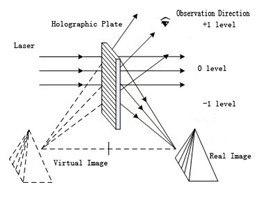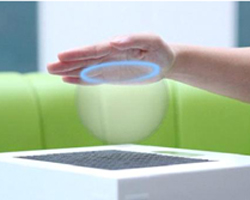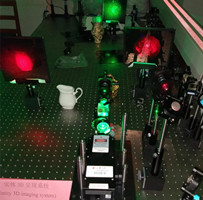|
Holography is divided into two processes which are recording and reproduction,the interference fringes is generated
on the
holographic plate through the superposition
between the reference light and the reflected light during the recording. Then, after the
holographic plate is processed in the darkroom, an image exactly same to the original object will be reproduced from the interference
pattern on the photosensitive sheet by
diffraction. Compared with ordinary photographic, Holography not only records the
amplitude
of light field of the object, but also records the relative phase of the reflected light waves. Holography is widely used in holographic
microscopy, holographic security,
data storage, deformation
measurement, holographic interferometry and etc.
Three-dimensional color holograms can
reflect the original information of
objects more accurately than
monochromatic holograms, so they have a
broad application prospect in
holographic display. In order to realize
high-definition, large-format and
THREE-DIMENSIONAL color holographic
display, holographic Angle multiplexing,
holographic rotation multiplexing and
holographic wavelength multiplexing are
used to realize multi-multiplexing
holographic display in liquid crystal
thin film, and RGB tri-color laser is
used to realize the reproduction of RGB
image components. The RGB image
components are recorded in three
different holograms, which are recorded
at the same recording point of the
liquid crystal film using angular
multiplexing. The green laser is used as
a recording light to record three
holograms at the same time, and then the
red, green and blue laser reads the
corresponding holograms respectively.
These three RGB images are combined into
three-dimensional color holograms.
At present,
three-dimensional color holographic
technology in three-dimensional film,
television, exhibition, microscopy,
interferometry, projection lithography
and surveillance, underwater detection,
metal interior detection, preservation
of precious historical relics, works of
art, information storage, remote
sensing, The study and recording of
transient phenomena, transient processes
(such as explosions and combustion) with
extremely rapid changes in physical
states have been widely used.
Changchun New Industries (CNI) founded
in 1996, is a manufacturer of solid-state
and diode laser systems. CNI laser
features with high performance, nice
reliability, and specifically designed
for OEM, scientific, industrial and
instrumentation use. In addition, CNI
lasers are ISO-9001, FDA, CE, RoHS and
JQA certified, CNI can provide the
single longitudinal mode, long coherent
length, high stability lasers for laser
holography and relevant components also
can be provided.
|
 |
 |
|
 |
 |
|
|
|
Features |
|
■
High reliability single longitudinal mode lasers
(
coherence length >100m )
■
Easy to install and maintain. Relevant components can be provided
■
Customized solution can be provided upon request |
|
Laser Related |
|
Wavelengths:
360 nm,
405 nm,
457 nm,
473 nm,
515 nm,
523.5 nm,
526.5 nm,
532 nm,
556 nm,
561 nm,
589 nm,
639 nm,
656.5nm, |
|
660 nm,
671 nm,
721 nm,
1064 nm,
1319 nm,
1342 nm,
1550 nm,
etc.
Multi-wavelengths
system is also available on request. |
|
|
|
|
|
 |
 |
 |
|
Interference fringes |
Etalon interference ring
|
Wavelength and linewidth test
|
|
|
|
|
Accessories |
|
|
|
|
|
Research achievements of CNI laser for Holography from customers
|
|
(1) Three-dimensional holographic photostimulation of the dendritic arbor
(J. Neural Eng. 8 046002; doi:10.1088/1741-2560/8/4/046002) (CNI-405nm)
(2) Two-wavelength exposure enhancement in holographic data storage of spirooxazine-doped polymers
(Optics Communications Vol. 338, 1 March 2015, Pages 269–276) (CNI-405nm)
(3) Depth resolved hyperspectral imaging spectrometer based on structured light illumination and Fourier
transform interferometry
(Biomedical Optics Express, Vol. 5, Issue 10, pp. 3494-3507 (2014))
( CNI-473nm)
(4) Optical magnetic imaging of living cells
(Nature 496, 486–489 (25 April 2013)doi:10.1038/nature12072)(CNI- 532nm)
(5)
Multi-wavelength laser sensor for intruder detection and discrimination
(Optics and Lasers in Engineering Vol. 50, Issue 2, Pages 176–181)
(CNI-532nm)
(6)
Optical observation of shock waves and cavitation bubbles in high intensity laser-induced shock processes
(Applied Optics, Vol. 48, Issue 19, pp. 3671-3680 (2009))
(CNI-532nnm)
(7)
Microscope spectrometer for light scattering investigations
(Applied Optics, Vol. 49, Issue 22, pp. 4193-4201 (2010))
( CNI-671nm/532nm)
|
|
|
|
|